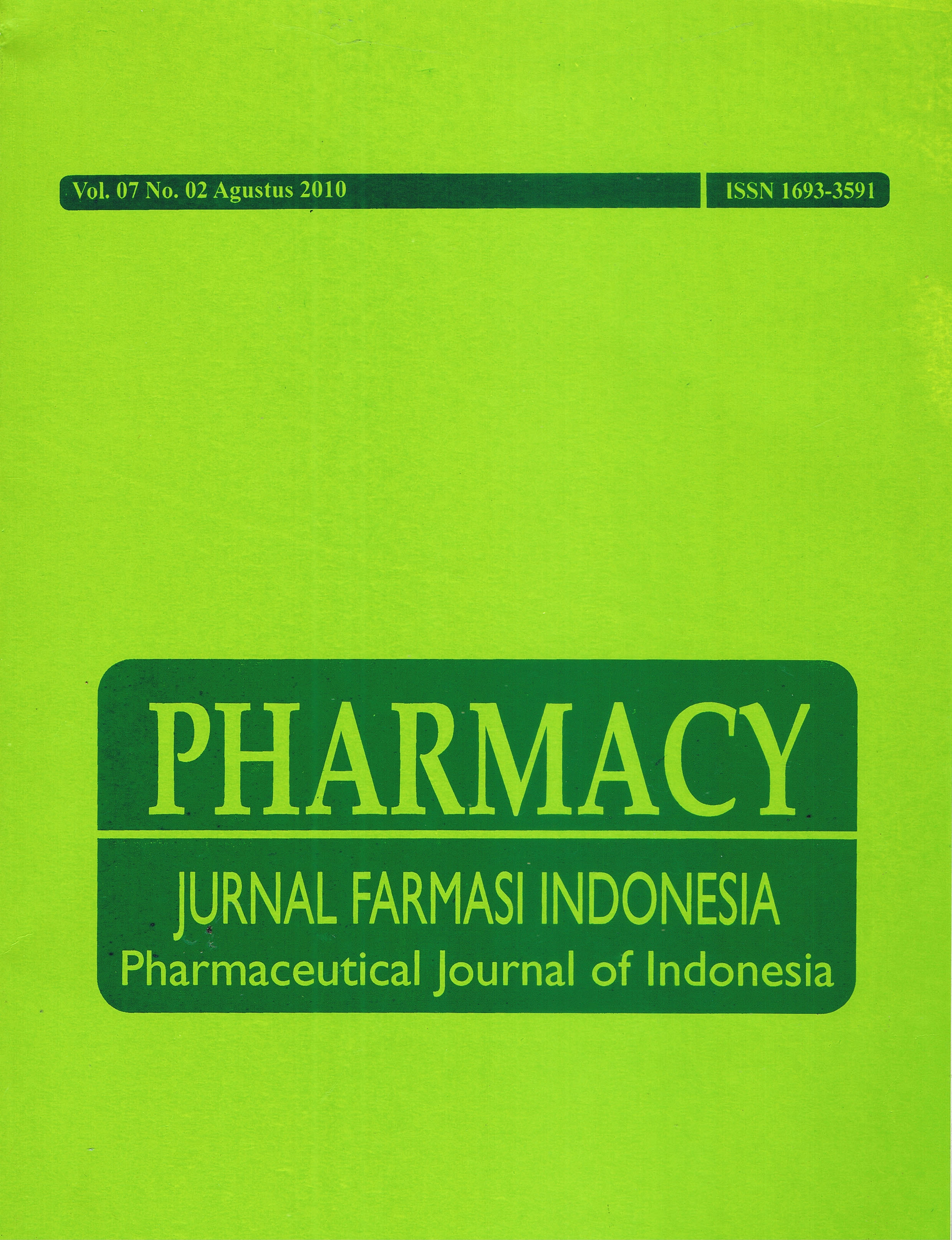AKTIVITAS ANTIBAKTERI GEL EKSTRAK LENGKUAS (Alpinia galanga) TERHADAP Pseudomonas aeruginosa DAN Bacillus subtilis.
DOI:
https://doi.org/10.30595/pji.v7i3.579Abstract
ABSTRAK Penelitian tentang aktivitas antibakteri gel ekstrak lengkuas terhadap Pseudomonas aeruginosa dan Bacillus subtilis dilakukan untuk mengetahui aktivitas antibakteri gel ekstrak lengkuas terhadap P. aeruginosa dan B. subtilis. Dalam penelitian ini ekstraksi dilakukan dengan metode maserasi dengan pelarut etanol 70%. Uji aktivitas antibakteri menggunakan metode difusi. Sifat fisik yang diuji adalah organoleptis, pH, dan viskositas. Senyawa minyak atsiri eugenol dan flavonoid diidentifikasi menggunakan KLT. Data viskositas dianalisis dengan uji anava dua arah dengan taraf kepercayaan 95% dan dilanjutkan uji BNT. Diameter zona hambat antibakteri dianalisis dengan uji anava satu arah dengan taraf kepercayaan 95% dan dilanjutkan uji BNT. Gel ekstrak lengkuas mempunyai sifat organoleptis dan pH yang stabil selama 28 hari, tapi viskositas gel menurun seiring bertambahnya hari. Gel ekstrak lengkuas memiliki aktivitas antibakteri terhadap P. aeruginosa, tapi tidak memiliki aktivitas antibakteri terhadap B. subtilis. Kata kunci: ekstrak lengkuas, aktivitas antibakteri, minyak atsiri eugenol dan flavonoid. ABSTRACT A research on antibacterial activity of ginger extract gel was done to know antibacterial activity of gel of ginger extract against Pseudomonas aeruginosa and Bacillus subtilis. In this research extraction was done by maseration method with 70% ethanol as solvent. Antibacterial activity test used diffusion method. Gel was tested pHysical properties for organoleptic, pH, and viscosity. Volatile oil and flavonoid compound were identified by TLC method. The viscosity data was analyzed by two way anava test with 95% significance level continued by LSD. The diameter of clear zone was analyzed by one anava with 95% significance level continued by LSD. Ginger extract is stable organolepticcally and pH for 28 days storage, but viscosity of gels decreases by time. The result showes that ginger extract gel has antibacterial activity against P. aeruginosa, but does not have antibacterial activity against B. subtilis. Key words: ginger extract (Alpinia galanga), antibacterial activity, volatile oil eugenol and flavonoid.References
Depkes, 1987. Analisis Obat Tradisional jilid I.Direktorat Jenderal Pengawasan Obat dan Makanan.
Depkes, 2004. Monografi Ekstrak Tumbuhan Obat Indonesia. Volume 1. Jakarta. Departemen Kesehatan Republik Indonesia.
Dian Mustikaningtyas, dkk. 2008.Isolasi, Identifikasi dan Uji Aktivitas Antibakteri Ekstrak Etil Asetat Rimpang Lengkuas Merah (Alpinia galanga). http://eprints.undip.ac.id/3118/1/Jurnal_Try_Nur.pdf. (8 maret 2010¬)
Sumono Agus dan Agustin W. 2009. Kemampuan air rebusan daun salam (Eugenia polyantha W) dalam menurunkan jumlah koloni bakteri Streptococcus sp. Dalam Majalah Farmasi Indonesia, 20(3), 112 – 117. Jember. FKG Jember.
Yuharmen, Yum Eryanti, Nurbalatif. 2002. Uji Aktivitas Antimikroba Minyak Atsiri dan Ekstrak Metanol Lengkuas (Alpinia galanga). http://www.unri.ac.id/jurnal/jurnal_natur/vol4(2)/yuharmen.pdf. Diakses pada 21 November 2009.
Downloads
Published
How to Cite
Issue
Section
License
Authors who publish with this journal agree to the following terms:
- Authors retain copyright and grant the journal right of first publication with the work simultaneously licensed under a Creative Commons Attribution 4.0 International License that allows others to share the work with an acknowledgement of the work's authorship and initial publication in this journal.
- Authors are able to enter into separate, additional contractual arrangements for the non-exclusive distribution of the journal's published version of the work (e.g., post it to an institutional repository or publish it in a book), with an acknowledgement of its initial publication in this journal.
- Authors are permitted and encouraged to post their work online (e.g., in institutional repositories or on their website) prior to and during the submission process, as it can lead to productive exchanges, as well as earlier and greater citation of published work (See The Effect of Open Access).






